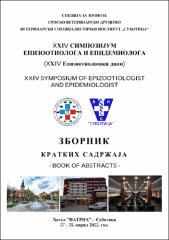Rezultati praćenja prisustva virusa Zapadnog Nila (WNV) na području Vojvodine u 2021

View/
Date
2022-04-27Author
Petrović, Tamaš
Petrić, Dušan
Vidanović, Dejan
Živulj, Aleksandar
Kisin, Bratislav
Filipović, Siniša
Janku, Đorđe
Lazić, Gospava
Lupulović, Diana
Kavran, Mihaela
Samojlović, Milena
Gajdov, Vladimir
Đurđević, Biljana
Pajić, Marko
Knežević, Slobodan
Šekler, Milanko
Metadata
Show full item recordAbstract
The concept and the results of the national integrated West Nile virus (WNV)
surveillance program conducted in 2021 at the territory of Vojvodina Province were
presented. The WNV surveillance program, funded by the Veterinary Directorate of
the Ministry of Agriculture, Forestry and Water Management, was conducted by the
veterinary service in collaboration with entomologists and ornithologists. The
objective of the program was early detection of WNV circulation in the environment
and timely reporting to the public health service and local authorities to increase both
clinical and mosquito control preparedness. The program was based on the detection
of WNV presence in wild birds as natural hosts and mosquitoes as virus vectors, and
on serological testing of sentinel horses for the presence of WNV-specific IgM
antibodies. WNV circulation was detected in all district of Vojvodina Province and
from beginning of August until the end of October 2021. The integrated WNV
surveillance program detected higher intensity of WNV circulation in 2021 than it
was in 2014 and 2015, but lower intensity than it was detected during season 2018.
Presence of WNV IgM antibodies in horse blood sera was detected in 1.08% (6/555)
of tested animals. The presence of WNV was detected in 11.43% (12/105) of wild
bird samples and in 26 (10.74%) out of 244 pool samples of Culex pipiens mosquitoes.
The WNV surveillance program in 2021 showed satisfactory results in view of
capacity to indicate the spatial distribution of the risk for humans.
